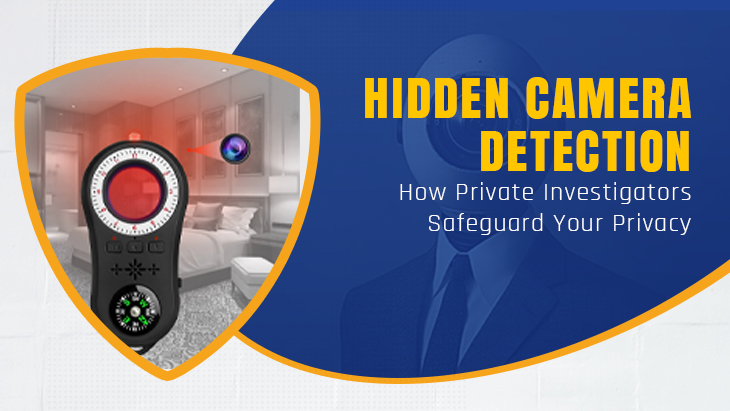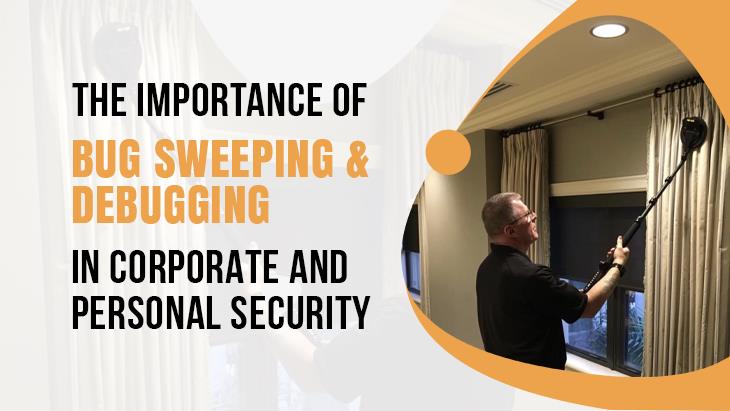Compact, cloud‑connected cameras are cheap, discreet, and everywhere. From rentals and hotel rooms to offices and dressing areas, a single hidden camera can violate privacy, expose trade secrets, or jeopardize safety. Private investigators trained in Technical Surveillance Counter‑Measures (TSCM) conduct discreet, end‑to‑end sweeps to find and neutralize covert cameras—and harden your space so threats don’t return.
This article is for general education, not legal advice. Surveillance and counter‑surveillance laws vary by jurisdiction. If you suspect criminal activity or immediate danger, contact local law enforcement.
Hidden camera detection is more than shining a flashlight. Pros combine physical inspection, optical lens detection, RF spectrum analysis, non‑linear junction detection (NLJD), thermal/power checks, and network audits—plus chain‑of‑custody reporting. Use DIY checks for a quick pass; rely on professional sweeps for certainty and legal‑grade documentation.
What is hidden camera detection?
Hidden camera detection is the systematic process of finding covert video devices—wired or wireless, recording locally or streaming over networks—and safely removing or neutralizing them. Professional TSCM teams layer methods to catch devices that are:
- Wireless (Wi‑Fi, cellular, analog)
- Wired (PoE/IP cameras, disguised cabling)
- Dormant (recording to SD card with no live transmission)
- Triggered (motion‑activated, packet‑burst, or timer‑based)
Why it matters
- Personal safety and dignity: Bedrooms, bathrooms, changing areas, rentals, hotel rooms.
- Corporate confidentiality: Boardrooms, R&D labs, legal war rooms, executive suites.
- Legal and financial risk: A single leak can damage cases, relationships, brand trust, and valuation.
Common concealment sites
Professionals prioritize high‑yield areas and objects that “belong” in a room:
- Smoke/CO detectors, motion sensors, air purifiers
- Alarm clocks, desk clocks, picture frames, wall hooks
- USB chargers, multi‑plugs, bulbs, light switches
- Vents, ceiling tiles, thermostats, sprinklers
- Mirrors (especially in bathrooms/bedrooms), TV bezels, set‑top boxes
- Soft furnishings (tissue boxes, plants, décor)
- In offices: conference phones, projectors, HDMI extenders, cable runs
Signs you may be watched
- New or out‑of‑place devices, adapters, bulbs, cables, or wall plates
- Tiny pinholes facing beds, showers, desks, or whiteboards
- Unusual heat from “passive” objects (charger, detector)
- Rogue Wi‑Fi SSIDs, unfamiliar devices on your network
- Unexplained leaks of confidential conversations or plans
How private investigators detect hidden cameras (step‑by‑step)
Pre‑brief and OPSEC
- Discreet intake, scope, floor plans, and threat modeling
- Prioritize bedrooms/bathrooms, meeting rooms, shared walls, and recent changes
Physical inspection (room by room)
- Systematic search of ceilings, vents, fixtures, wall plates, furniture, décor
- Look for tool marks, fresh adhesives, mismatched screws, unusual power taps
Optical and IR lens detection
- Lens finders/laser reflection in low light to spot pinhole lenses
- Angled passes around likely sight lines (bed, bath, boardroom table)
RF spectrum analysis
- Wideband scanning for 2.4/5 GHz Wi‑Fi cameras, sub‑GHz analog transmitters, cellular modules
- Near‑field probes to localize signals; demodulation checks for video payloads
Non‑linear junction detection (NLJD)
- Finds hidden electronics—even powered off—inside walls, ceilings, furniture, or objects
Thermal/power analysis
- Detects heat signatures; flags abnormal loads on mains/PoE that indicate wired IP cameras
Wiring and network audits
- Trace Ethernet/HDMI/telephony runs; inspect patch panels and PoE switches for rogue devices
- Network survey: map SSIDs/devices, find default/weak creds, analyze traffic anomalies
Evidence handling and remediation
- Photograph and isolate devices; maintain chain‑of‑custody
- Safe removal/neutralization and immediate hardening steps
- Confidential report with findings, RF logs, timestamps, and remediation plan
Hire the best Detective Agency in Mumbai for professional, discreet debugging and bug-sweeping with state-of-the-art tools and expert service.
Hotel/Airbnb traveler checklist (DIY, safe and quick)
Use this for a quick pass—then call pros if anything looks off.
- Darken the room; slowly scan with a lens detector or strong flashlight for pinhole reflections aimed at shower/bed/work areas.
- Inspect common hides: smoke detectors, alarm clocks, USB chargers, wall hooks, vents, TV bezels.
- Check mirrors at oblique angles with light; look for pinhole lenses near eye‑level.
- Scan Wi‑Fi with your phone for unfamiliar SSIDs/devices; turn off “auto‑join” on unknown networks.
- If you find something suspicious: don’t announce it in‑room. Leave, document from a safe location, contact management and law enforcement, and call a professional TSCM team.
Legal and ethical steps if you find a device
- Do: Move to a safe place before discussing; photograph in situ; preserve timestamps; contact police/platform; engage professionals for evidence‑safe removal.
- Don’t: Destroy or discard the device; use RF jammers (illegal in many places); confront suspects directly.
Aftercare: hardening your environment
- Physical: Secure ceiling access, lock AV/IT closets, use tamper‑evident seals
- Network: Rotate Wi‑Fi keys, segment IoT/guest, disable UPnP, enforce MFA
- Procedures: Device‑free protocols for sensitive meetings; pre‑meeting room checks
- Monitoring: Periodic sweeps, spot checks during renovations/staff changes/travel
How to choose a provider
- Credentials: TSCM training, relevant security certifications (e.g., ASIS CPP/PSP)
- Equipment and methods: RF, NLJD, optical, thermal, wiring, network, vehicle coverage
- Independence: Vendor‑neutral; no “spy gadget” sales conflicts
- Reporting: Chain‑of‑custody, photos, RF logs, clear remediation
- Discretion and references: Experience with board‑level and high‑profile residential clients
- Scope and pricing clarity: Defined areas, time on site, disruption plan, follow‑up support
Myths vs reality
- Myth: “Your phone can find everything.” Reality: Phones miss dormant/wired devices; lens reflection is not foolproof.
- Myth: “Turn off Wi‑Fi and you’re safe.” Reality: Cameras can record locally to SD or use cellular.
- Myth: “Cheap detectors are enough.” Reality: Many devices are packet‑burst or hidden in wiring—layered methods are required.
- Myth: “One sweep fixes it forever.” Reality: Pair sweeps with policies, access control, and periodic checks.
FAQs
Q: Can a phone detect hidden cameras?
A: Phones can help find Wi‑Fi devices and catch some lens reflections, but they won’t reliably detect dormant or wired cameras. Pros use NLJD, RF, optical, thermal, and wiring/network methods.
Q: How do pros find powered‑off cameras?
A: NLJD detects the semiconductor junctions inside electronics—even without power—plus physical and thermal checks to confirm.
Q: Will a sweep damage property?
A: Professional sweeps are non‑destructive. If removal is needed, teams use careful methods and document everything for legal follow‑up.
Q: How long does a hidden camera sweep take?
A: From a few hours (single room/vehicle) to a full day or more (multi‑room homes/offices), depending on size and complexity.
Q: What if I’m in a hotel or rental and suspect a camera?
A: Leave the room, document safely, contact management and police, and call a professional. Avoid touching or powering devices repeatedly.
Ready to secure your space?
Protect your privacy with Spy Detective Agency , the best detective agency in Delhi India.
- Discreet hidden camera sweeps for homes, rentals, hotels, offices
- RF, optical, NLJD, wiring, and network checks
- Legal‑grade reporting and remediation
- Book a Debugging and Sweeping Services Today!
- Call/ Whatsapp : +91 – 999 933 5950
We respond within 1 business day. If you suspect active criminal activity, contact law enforcement immediately.




